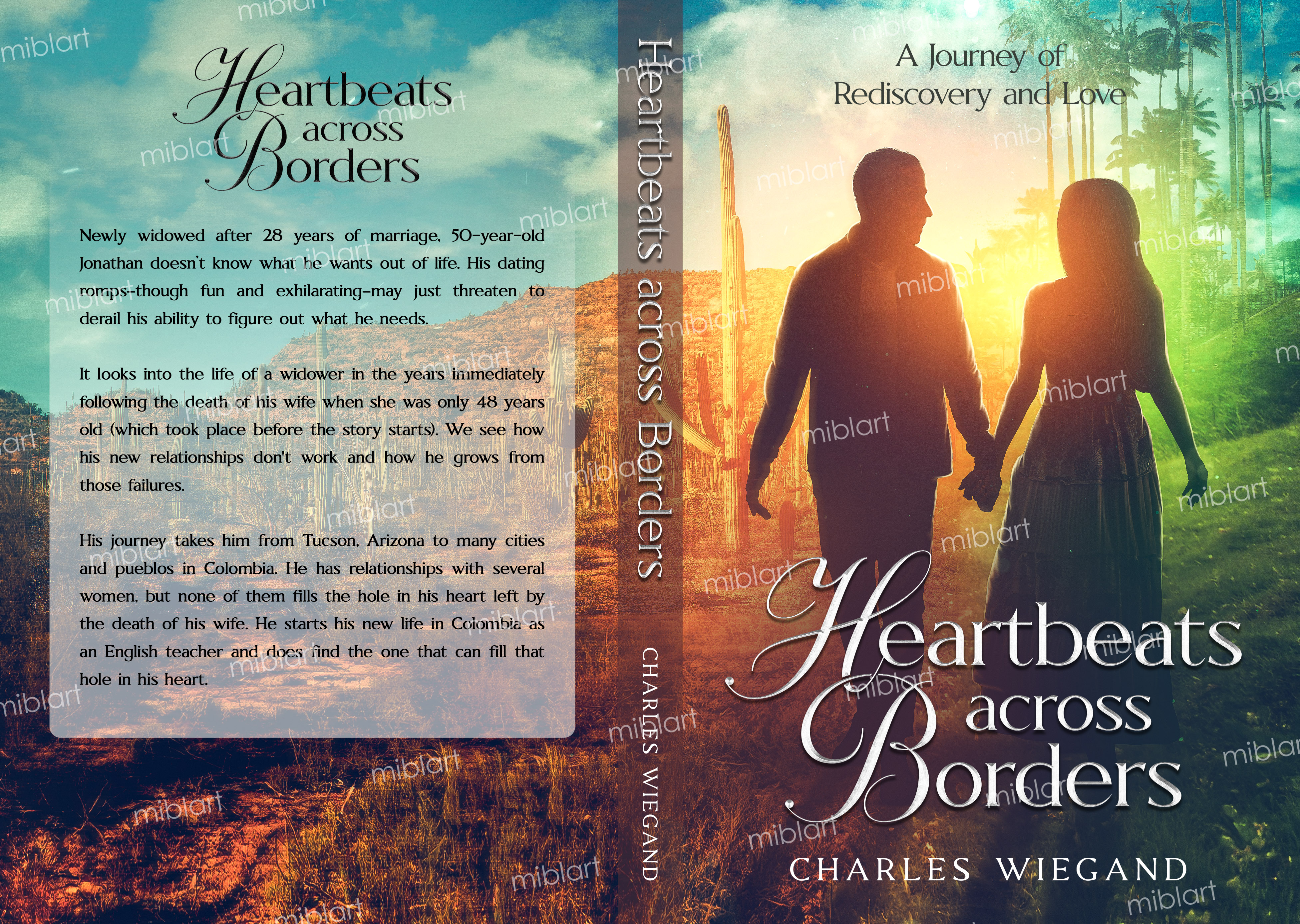

My book "Heartbeats Across Borders" is available now on Amazon.com! Be sure to get your copy! And sign up for my mailing list.

A Collection of Short Stories

Two hearts, two countries, one love

Dec. 26, 2024
Traveling through South America gives you an interesting exploration of many different cultures, histories, and languages. Having visited and lived in multiple countries across the continent, I've come to appreciate the distinct variations not just in accents, but also in everyday language, as influenced by the region's colonial past, European immigration, and indigenous cultures.
My current trip started in Arequipa, Perú on Oct. 30, 2024. Interesting note: My first journey, from Roldanillo, Colombia, started on Oct. 30, 2022. That first journey took me through Ecuador, Perú, Chile, Argentina, Paraguay, Uruguay, and a few border towns in Brasil. That included visiting 110 cities and other sites. The return journey heading north because it was winter and cold in Uruguay and Argentina, started on June 20, 2023. That return journey included visiting 50 cities. I then stayed in Roldanillo, again, for six months. Then I started another journey south, taking as much as possible as different route, on March 1, 2024. I cruised across Ecuador and into Perú and eventually stopped and lived in Arequipa, in southern Perú, for six months. That short journey included visiting 37 cities. I then started on another southward journey on Oct. 30, 2024. I am now on that journey, and have so far visited 15 cities. By the time I finish this journey in Encarnación, Paraguay, I will have visited 20 cities. When I lived in Colombia for about 9 1/2 years I visited more than 80 cities. All told, so far in South America, I have visited 304 cities, towns, and other sites.
One thing that's particularly striking is the comparison between countries like Argentina and the northern half of South America. Argentina, a much younger country in terms of urban development, offers a much different experience than places like Perú, Ecuador, and Colombia, which boast cities that are hundreds of years older and steeped in colonial history. While Argentina's towns are often less historically rich in terms of colonial architecture, they have a distinct European flavor, thanks in part to the country's mass European immigration in the 19th and 20th centuries. This influence is visible in everything from the urban design in cities like Buenos Aires to the food, with Italian and Spanish flavors dominating the cuisine.
The European influence in Argentina contrasts sharply with the more indigenous and colonial-rooted countries in the north. In places like Colombia and Ecuador, the cities are older, and the colonial legacy is still very much alive in the architecture and the way people engage with history. Argentina, on the other hand, feels very much like a product of the 19th and 20th centuries, shaped by modern influences from Europe.
One of the things that stands out the most about Argentina is the "European" feel that permeates the culture. From the architecture to the food, to the societal attitudes, Argentina feels much closer to Europe than any other Latin American country. The massive influx of immigrants, particularly Italians and Spaniards, during the late 19th and early 20th centuries created a cultural mix that made Argentina stand out from its neighbors. Buenos Aires, often called the "Paris of South America," with its wide boulevards and French-inspired architecture, epitomizes this European influence.
This "European" aspect also manifests in the Argentine accent and vocabulary. The Rioplatense Spanish, spoken primarily in Buenos Aires and surrounding areas, is distinct from the rest of Latin America. For example, the pronunciation of the "ll" and "y" sounds sets Argentina apart: these are pronounced as a "zh" or "sh" sound (like in "measure"), whereas in Colombia, the "ll" is pronounced as a soft "j" followed by a "y" sound, with the "y" often sounding like a "j" in English. This distinctive accent can sound almost like Italian, reflecting the heavy Italian influence on the country. The "voseo", or use of "vos" instead of "tú" for "you," also adds to the unique flavor of Argentine Spanish.
Along with the above described European feel found in Argentina you will also find this negative aspect that may also be related to it's Euro-vibe - cigarette smoking. In many European countries, especially Italy and France, smoking has historically been more socially acceptable and prevalent. This cultural attitude has apparently carried over to Argentina. Also, smoking rates across South America have been declining due to public health campaigns, taxation, and smoking bans, Argentina has been slower to implement some measures compared to its neighbors. For example, Uruguay, a world leader in tobacco control, has aggressively cut down smoking rates with strict regulations, while Argentina has faced challenges in enforcing similar measures. Smoking is often associated with social gatherings or leisure activities in Argentina, particularly in urban areas like Buenos Aires. It's not uncommon to see groups of people smoking in outdoor cafes, parks, or public spaces, which might make it feel more noticeable. I've seen this often in the smaller cities that I have visited. Some countries, particularly Colombia and Perú, generally have lower smoking rates, partly due to stronger anti-smoking campaigns and cultural norms where smoking is less common or seen as less socially acceptable. The difference between smoking in Argentina and smoking in any other South American country is strikingly noticable. Yet, thankfully, the rate of smoking has been decreasing, just slowly.
Tattoos are also very common throughout Argentina and Chile, especially for young women. Both of these countries are more liberal the pretty much all the rest of South America, and with the European influence (where tattoos have always been much more socially acceptable) you will see just about every woman apparently under the age of 40 with multiple tattoos, often many, on her arms and legs. In these two countries tattoos are seen and accepted as a form of self-expression. In Paraguay, in contrast, it is not socially acceptable for a woman to have tattoos. Also, tattoos can be linked to economic accessibility, meaning, the more affluent are more likely to have tattoos. Chile and Argentina both have a much larger urban middle-class with more open easy access to global trends. Then there are the cultural differences. Perú, Ecuador, and Colombia are all old-culture countries, much older than Argentina and even Chile, and in those countries which are much more conservative. Yes, there has been an increase in young women getting tattoos, but that is mostly constrained to the large urban areas.
The Differences Between Argentina and Colombia
Having spent nearly a decade living in Colombia, with seven of those years in Barranquilla, I've also noticed striking differences in the way Spanish is spoken across South America. In Colombia, the pronunciation of the "ll" sound varies widely by region. In Colombia's Paisa region (including Medellín), the accent is often quite musical, almost sing-songy, and shares similarities with the Argentine accent. On the other hand, the Caribbean coast accent in places like Barranquilla and Santa Marta is faster-paced, with clipped words and a more rapid flow of speech.
In contrast, the Cachecos of Bogotá (the capital) are reputed to speak the "purest" form of Spanish, according to locals—though this claim is somewhat subjective. What's clear is that the accents and the way people pronounce and shorten words across Colombia can feel drastically different.
In Colombia, "nena" is a common term of endearment used to refer to a woman or girl, similar to "sweetie," "darling," or "honey" in English. For example, it's often used by waitresses addressing customers in a casual, affectionate manner. It's a term of warmth and familiarity, and it's widely used in everyday life. Interestingly, many Colombian women even prefer the term "nena" over "chica", a word that is more commonly used in Argentina to refer to young women, and I have heard middle-aged women refer to other middle-aged women using the word "chica". In Argentina, the word "chica" is more neutral and widely used to refer to young women, whereas "nena" is still affectionate but more commonly used in a familial or romantic context.
Learning Spanish in South America
During my time in Colombia, I learned Spanish primarily "in the street" and through informal conversations rather than in a classroom. This style of learning, while challenging, offered an immersive experience that made me feel deeply connected to the culture. It wasn't always easy—especially when it came to mastering verb conjugations—but over time, I became conversationally fluent. The beauty of learning informally was that I was always engaging with the language in real-world situations, whether I was teaching English to business professionals or chatting with locals. In fact, my students often ended up teaching me Spanish more than I taught them English! I had to remind them quite often that they were paying me to teach them, not for them to teach me.
Despite over 11 years in South America, I still find that my use of Spanish verbs could be much stronger. This is something I've noticed many learners face—people tend to understand me just fine, but they rarely correct me. This is especially true when speaking with locals who don't want to interrupt the flow of conversation or come across as rude. Even when I specifically ask for corrections, it's often not offered. This dynamic highlights a common challenge many language learners face: it's tough to improve if you're not getting direct, constructive feedback.
South America's linguistic diversity is one of its most fascinating aspects. From the musical tones of Paisa Spanish in Medellín to the clipped speech of the Costeños in Barranquilla and the Caribe coast, and the distinctive Rioplatense Spanish of Argentina, each country and region offers its own unique flavor of the Spanish language. The cultural nuances and accents provide endless learning opportunities, making every conversation an adventure in linguistic discovery.
Whether it's in the streets of Barranquilla, the busy cafés of Buenos Aires, or the markets of Medellín, the language you speak is not just about words; it's about connection, culture, and identity. South America may be vast and varied, but the beauty of speaking Spanish, no matter where you are, is that it unites us all in a shared cultural and linguistic tapestry.
During my first southward journey, along the border of Uruguay and Brazil, they don't speak regular Spanish or Portuguese, the speak a mix of the two called Portuñol (Portugues and Español mixed). When I visited Rivera, Uruguay, and Santana do Livramento, Brazil, this was the normal language and I found it very difficult to understand. Another thing I discovered - the people in those towns won't help you understand, if you don't get it, you're simply out of luck. Along the Parguay/Brasil border you're likely to also hear Guaraní mixed into the Portuñol.
The two mixed languages can also cause problems for the locals. Some words look or sound similar in Portuguese and Spanish but have entirely different meanings ("embarazada" in Spanish (means pregnant in English), but in Portuguese, "embarassada" means embarrassed). And since portuñol is not a standarized language, it is simply a localized blending of two languages, there are no grammar rules for its use. So, anyone trying to use Portuñol in formal situations will find it quite difficult.
On November 26th, I stopped in a panadería (bakery) and asked about the filling in some small pies. The woman told me 'membrilla' and I asked what that is, as it was the first time hearing the word. A man who was at the cash register piped in (in English). He said membrilla is quince (he pronounced it as KEEN-say, the Spanish word for 'fifteen'. This then brought the two of us into a discussion because I have never in my life come across the word 'quince' in English, only in Spanish, and I know it means "fifteen". He explained that when he lived in San Fransisco he often had KEEN-say fruit for a filler in pies. This argument went on for several minutes, and we each had our phones out looking for quince fruit. Well, I learned something new about my old neighboring state, California, and a new word in English - quince. The fruit name is pronounced, in English, 'kwins', and the fruit is a very niche fruit in California. I bought the little pie and the quince flavor is very sweet. Too sweet, in fact, that I couldn't eat all of the pie, and it is small, similar in size probably to a single slice of a regular-size pie. But, it is quite tasty.
While in Córdoba, I noticed that the people, in general, appeared to be happier, or in a better mood, or simply experiencing better lives, than the last time I visited AR. The last time I visited the norther half and the people were obviously down-spirited, I could see it in everyone's faces, in their eyes. This time, though, it was a much different feeling. I asked a young lady in a tienda (convenience store) about this and she said Yes, the economy is better and people in general do feel much better compared to two years ago.
I found Argentina to be much more expensive that I remembered it from almost 2 years ago, and so, after visiting Córdoba, I took a bus directly to Asunción, Paraguay, then after visiting the tiny town of Paraguarí, I bused directly to Encarnación. I have now settled here. I found a fully furnished 2-bedroom apartment just 2 blocks from the beach and riverside park, and 4 blocks from the city center. The rent? About US$300 including all services except electricity. And it's a building with 24/7 security. I'll start the process to obtain a residence visa the first week of January. I've visited Encarnación several times before and really like this small city. You can find my previous blogs about it by doing a search for "Encar" in the search box. Those accented letters tend to through off the search results.